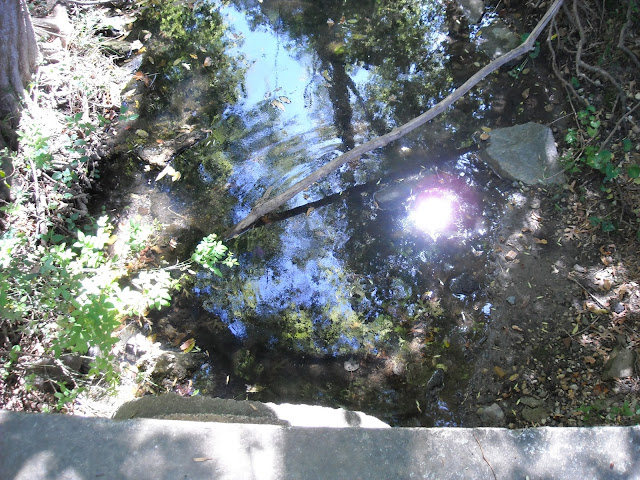I've always had an infatuation with small urban creeks and streams. Perhaps it's because I grew up around one, or maybe it's a glaring reminder that the natural landscape history of our vast cities still exists and still deserves our care.
Sligo Creek and it's surrounding valley provides an oasis for native trees and wildlife in a densely urban setting. Sligo creek flows through the Maryland suburbs of Washington, DC, and I had the opportunity to track its entire course through Montgomery and Prince George's County via the
Sligo Creek Trail.
The stream collects runoff and perhaps some spring water from the Franwall Avenue neighborhood in Silver Spring, Maryland (see Map 1). The water then collects into a storm drain, which ominously emerges into a stream channel from an underground culvert (see Photo A).
Map 1: Headwaters of Sligo Creek. The green pushpin is the location
of the residential neighborhood that drains water into the creek.
View Larger Map
 |
| Photo A: Sligo creek emerges from a culvert which channels runoff from a residential neighborhood in Silver Spring Maryland, beginning it's 10 mile journey down to the Anacostia River. |
The neighbors along Franwall Avenue and Nairn Road in Silver Spring make the first direct impact on this urban stream, as anything they do on their lawn or dump down the storm drain eventually washes into Sligo Creek and heads downstream. Their yards are at the upper stretches of the Sligo Creek
watershed, or an area of land where water eventually "sheds" into the creek, bringing with it leaf debris, litter, gasoline, fertilizers, and whatever else people dump out onto the ground. The Sligo Creek watershed is in fact a
subwatershed, or a distinct watershed within another larger watershed. The overall "hierarchy" of watersheds is shown here:
 |
| Figure 1: The hierarchy of watersheds for the Sligo Creek subwatershed. |
As it trickles downstream through the Sligo Valley Park, it becomes surrounded by deceivingly pristine hardwood forests, with large stands of American Beech (
Fagus grandifolia), red and white oaks (
Quercus spp.), tulip trees (
Liriodendron tulipifera), and
flowering dogwoods (
Cornus florida). On my journey I observed
White-breasted Nuthatches (
Sitta carolinensis) climbing down a tree eating insects that the upward-climbing Downy Woodpecker (
Picoides pubescens) missed. I could hear a great-crested flycatcher (
Myiarchus crinitus) giving its distress call while a
red-tailed hawk (
Buteo jamaicensis) soared overhead.
 |
| Photo B: Sligo Creek as it meanders towards the Prince George's County line. Although the stream channel remains n a predominantly natural state, most of the watershed is covered with urban development. |
The image of the creek in Photo B is deceptive in that it does not show the surrounding urban development, as this creek is only a few short miles from Washington, DC. As the city and suburbs enveloped the upland areas of the Sligo Creek watershed, polluted runoff from parking lots, dump yards, fertilized lawns, and other anthropomorphic substrates rushed into Sligo Creek. By the early 1990s, only three species of fish were surviving in the shallow stream (according to an interpretive sign along the Sligo Creek Trail). Environmental awareness and ecological restoration of the creek and some of the surrounding areas has restored the fisheries of Sligo Creek to about 11 different species. This is due in part to the retardation of urban runoff through rain gardens, reforestation, and retention ponds.
 |
| Photo C: A recently constructed retention basin near Sligo Creek intended to slow urban runoff and filter pollutants. |
The the last mile of Sligo Creek before its
confluence, or where it meets the Northwest Branch of the Anocostia River, is characterized by a more disturbed and open landscape. False sunflower (
Heliopsis helianthoides L.) blossoms along moist woodland edges and serves an an important pollination source for various bees and insects. The unfortunate invasive Kudzu vine (
Pueria lobata) is present and dangles over trees and utilities.
 |
| Photo D: False sunflower in bloom on September 18, 2013 near mile-marker 1 on the Sligo Creek Trail in Prince George's County, Maryland |
 |
| Photo E: Invasive Kudzu vine in bloom |
The stream then flows into the Northwest Branch of the Anocostia, and makes its way down to the District of Columbia and beyond, providing valuable wildlife habitat in a densely, densely populated area. Despite the region's continuing urban problems, the trickle of water from Sligo Creek reminds us that we're, quite literally, connected to the region as a whole.
 |
| Photo F: A beach along the Atlantic Ocean, where we all eventually connect. |










Comments
Post a Comment